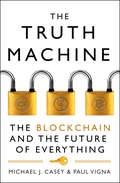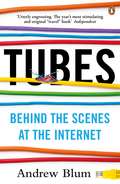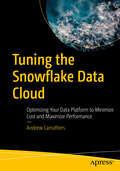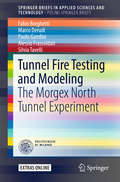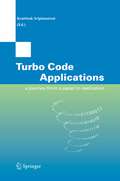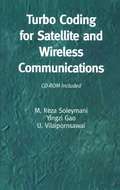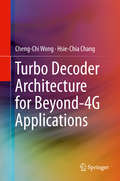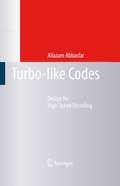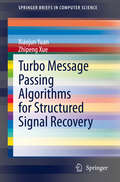- Table View
- List View
The Truth Machine: The Blockchain And The Future Of Everything
by Michael J. Casey Paul VignaFrom the authors of the fascinating The Age of Cryptocurrency, comes the definitive work on the Internet’s next big thing: the blockchain.
Truth, Proof and Infinity: A Theory of Constructive Reasoning (Synthese Library #276)
by P. FletcherConstructive mathematics is based on the thesis that the meaning of a mathematical formula is given, not by its truth-conditions, but in terms of what constructions count as a proof of it. However, the meaning of the terms `construction' and `proof' has never been adequately explained (although Kriesel, Goodman and Martin-Löf have attempted axiomatisations). This monograph develops precise (though not wholly formal) definitions of construction and proof, and describes the algorithmic substructure underlying intuitionistic logic. Interpretations of Heyting arithmetic and constructive analysis are given. The philosophical basis of constructivism is explored thoroughly in Part I. The author seeks to answer objections from platonists and to reconcile his position with the central insights of Hilbert's formalism and logic. Audience: Philosophers of mathematics and logicians, both academic and graduate students, particularly those interested in Brouwer and Hilbert; theoretical computer scientists interested in the foundations of functional programming languages and program correctness calculi.
Truth, Rationality, Cognition, and Music (Philosophical Studies Series #102)
by Jesus M. Larrazabal KepaKortaA speech for the defence in a Paris murder trial, a road-safety slogan, Hobbes' political theory; each appeals to reason of a kind, but it remains an oblique and rhetoricalldnd. Each relies on comparisons rather than on direct statements, and none can override or supersede the conclusions of ethical reasoning proper. Nevertheless, just as slogans may do more for road safety than the mere recital of accident statistics, or of the evidence given at coroners' inquests, so the arguments of a Hobbes or a Bentham may be of greater practical effect than the assertion of genuinely ethical or political statements, however true and relevant these may be. Stephen Toulmin, Reason in Ethics, 1950. The International Colloquium on Cognitive Science (ICCS), held in Donostia - San Sebastian every two years since 1989, has become one of the most important plazas for cognitive scientists in Europe to present the results of their research and to exchange ideas. The seventh edition, co-organized as usual by the Institute for Logic, Cognition, Language, and Information (ILCLI) and the Department of Logic and Philosophy of Science, both from the University of the Basque Country, took place from May 9 to 12, 200 1, addressing the following main topics: 1. Truth: Epistemology and Logic. 2. Rationality in a Social Setting. 3. Music, Language, and Cognition. Vlll TRUTH, RATIONALITY, COGNITION, AND MUSIC 4. The Order of Discourse: Logic, Pragmatics, and Rhetoric.
The TSQL2 Temporal Query Language (The Springer International Series in Engineering and Computer Science #330)
by Richard T. SnodgrassTemporal databases have been an active research topic for at least fifteen years. During this time, several dozen temporal query languages have been proposed. Many within the temporal database research community perceived that the time had come to consolidate approaches to temporal data models and calculus based query languages, to achieve a consensus query language and associated data model upon which future research can be based. While there were many query language proposals, with a diversity of language and modeling constructs, common themes kept resurfacing. However, the community was quite frag mented, with each research project being based on a particular and different set of assumptions and approaches. Often these assumptions were not germane to the research per se, but were made simply because the research required a data model or query language with certain characteristics, with the partic ular one chosen rather arbitrarily. It would be better in such circumstances for research projects to choose the same language. Unfortunately, no existing language had attracted a following large enough to become the one of choice. In April, 1992 Richard Snodgrass circulated a white paper that proposed that a temporal extension to SQL be produced by the research community. Shortly thereafter, the temporal database community organized the "ARPA/NSF In ternational Workshop on an Infrastructure for Temporal Databases," which was held in Arlington, TX, in June, 1993.
Tubes: Behind the Scenes at the Internet
by Andrew BlumThe Internet. Home to the most important and intimate aspects of our lives. Our careers, our relationships, our selves, all of them are out there - online. So ... where is that exactly? And who's in charge again? And what if it breaks?In Tubes Andrew Blum takes us on a gripping backstage tour of the real but hidden world of the Internet, introducing us to the remarkable clan of insiders and eccentrics who own, design and run it everyday. He uncovers the secret data warehouses where our online selves are stored, peels back the wires that transport us across the globe, reveals its mammoth hubs and surprising alley-ways, explaining what the Internet actually is, where it is, how it got there - and, yes, what happens when it breaks.
Tuning Metaheuristics: A Machine Learning Perspective (Studies in Computational Intelligence #197)
by Mauro BirattariTuning the Snowflake Data Cloud: Optimizing Your Data Platform to Minimize Cost and Maximize Performance
by Andrew CarruthersThis project-oriented book presents a hands-on approach to identifying migration and performance issues with experience drawn from real-world examples. As you work through the book, you will develop skills, knowledge, and deep understanding of Snowflake tuning options and capabilities while preparing for later incorporation of additional Snowflake features as they become available. Your Snowflake platform will cost less to run and will improve your customer experience. Written by a seasoned Snowflake practitioner, this book is full of practical, hands-on guidance and advice specifically designed to further accelerate your Snowflake journey. Tuning the Snowflake Data Cloud provides you a pathway to success by equipping you with the skills, knowledge, and expertise needed to elevate your Snowflake experience. The book shows you how to leverage what you already know, adds what you don’t, and helps you apply it toward delivering for your Snowflake accounts. Read this book to embark on a voyage of advancement and equip your organization to deliver consistent Snowflake performance. What You Will Learn Recognize and understand the root cause of performance bottlenecks Know how to resolve performance issues Develop a deep understanding of Snowflake performance tuning options Reduce expensive mistakes, remediate poorly performing code Manage Snowflake costs
Tunnel Fire Testing and Modeling: The Morgex North Tunnel Experiment (SpringerBriefs in Applied Sciences and Technology)
by Fabio Borghetti Marco Derudi Paolo Gandini Alessio Frassoldati Silvia TavelliThis book aims to cast light on all aspects of tunnel fires, based on experimental activities and theoretical and computational fluid dynamics (CFD) analyses. In particular, the authors describe a transient full-scale fire test (~15 MW), explaining how they designed and performed the experimental activity inside the Morgex North tunnel in Italy. The entire organization of the experiment is described, from preliminary evaluations to the solutions found for management of operational difficulties and safety issues. This fire test allowed the collection of different measurements (temperature, air velocity, smoke composition, pollutant species) useful for validating and improving CFD codes and for testing the real behavior of the tunnel and its safety systems during a diesel oil fire with a significant heat release rate. Finally, the fire dynamics are compared with empirical correlations, CFD simulations, and literature measurements obtained in other similar tunnel fire tests. This book will be of interest to all engineers and public officials who are concerned with the nature, prevention, and management of tunnel fires.
Tunnel und verdeckte Kanäle im Netz: Grundlagen, Protokolle, Sicherheit und Methoden
by Steffen WendzelDass Netzwerkdaten eingebettet in andere Daten (Tunneling) gesendet werden, ist ein Grundprinzip des heutigen Internets. Ob im bisherigen Internet Protocol oder in der kommenden Version, in Transport- oder Anwendungsprotokollen: ohne Tunneling ist der Betrieb moderner Netzwerke nur eingeschränkt möglich. Neben Grundlagen, Protokollen und Fragen der Sicherheit beim Tunneling wird in dem Band auch die verdeckte Netzwerkkommunikation erläutert. Sie ist eine Form der Datenübertragung, bei der der Kommunikationsprozess an sich verborgen bleibt.
Tunneling Dynamics in Open Ultracold Bosonic Systems: Numerically Exact Dynamics – Analytical Models – Control Schemes (Springer Theses)
by Axel U. LodeThis thesis addresses the intriguing topic of the quantum tunnelling of many-body systems such as Bose-Einstein condensates. Despite the enormous amount of work on the tunneling of a single particle through a barrier, we know very little about how a system made of several or of many particles tunnels through a barrier to open space. The present work uses numerically exact solutions of the time-dependent many-boson Schrödinger equation to explore the rich physics of the tunneling to open space process in ultracold bosonic particles that are initially prepared as a Bose-Einstein condensate and subsequently allowed to tunnel through a barrier to open space. The many-body process is built up from concurrently occurring single particle processes that are characterized by different momenta. These momenta correspond to the chemical potentials of systems with decreasing particle number. The many-boson process exhibits exciting collective phenomena: the escaping particles fragment and lose their coherence with the source and among each other, whilst correlations build up within the system. The detailed understanding of the many-body process is used to devise and test a scheme to control the final state, momentum distributions and even the correlation dynamics of the tunneling process.
Turbo C-Wegweiser Grundkurs
by Ekkehard KaierDas vorliegende Wegweiser-Buch führt den Leser zum erfolgreichen Ein satz von Turbo C und ist in die drei Abschnitte Grundlagen, Turbo C und Programmierkurs mit Turbo C gegliedert. Abschnitt "I Grundlagen": Das Wegweiser-Buch vermittelt aktuelles Grundlagenwissen zur Programmentwicklung allgemein: Was sind Datentypen und Datenstrukturen? Welche Programmstrukturen unterscheidet die Informatik? Wie lassen sich Daten- und Programmstrukturen als Software-Bau steine anordnen? Was versteht man unter der Datei als Datenstruktur? Nach der Lektüre dieses Abschnitts sind Sie in der Lage, die Programm miersprache Turbo C in den Gesamtrahmen der "Datenverarbeitung bzw. Informatik" einzuordnen. Abschnitt "II Turbo C": Das Wegweiser-Buch gibt einen detaillierten Überblick zu Bedienung und Definitionen von Turbo C als Programment wicklungssystem: Wie installiert man das Turbo C-System? Wie erstellt man das erste Programm in Turbo C? Wie bedient man den Editor und den Compiler? Welche Befehle werden zur Softwareentwicklung bereitgestellt? Welche Datentypen, Operatoren und Funktionen stellr das Ent wicklungssystem zur Verfügung? Nach der Lektüre dieses Abschnitts können Sie das Turbo C-System be dienen sowie einfache Programme editieren, speichern, übersetzen und ausführen lassen. Abschnitt "111 Programmierkurs mit Turbo C -Grundkurs": Hier wird ein kompletter Programmierkurs mit den folgenden Problemkreisen angebo ten: Programme zu den einfachen Datentypen. Programme zu -den wichtigen Ablaufstrukturen (Folge-, Auswahl, Wiederholungs- und Unterprogrammstrukturen). Strukturiertes Programmieren (Funktionen, Lokalisierung von Be zeichnern, Parameterübergabe ). Textverarbeitung mit Strings als strukturiertem Datentyp. Tabellenverarbeitung mit Arrays als strukturiertem Datentyp. Dateiverarbeitung sequentiell und im Direktzugriff. VI Vorwort Zahlreiche Aufgaben dienen dem Einüben, Kontrollieren und Anwenden.
Turbo Code Applications: a Journey from a Paper to realization
by Keattisak SripimanwatTurbo Code Applications: a journey from a paper to realization presents c- temporary applications of turbo codes in thirteen technical chapters. Each chapter focuses on a particular communication technology utilizing turbo codes, and they are written by experts who have been working in related th areas from around the world. This book is published to celebrate the 10 year anniversary of turbo codes invention by Claude Berrou Alain Glavieux and Punya Thitimajshima (1993-2003). As known for more than a decade, turbo code is the astonishing error control coding scheme which its perf- mance closes to the Shannon’s limit. It has been honored consequently as one of the seventeen great innovations during the ?rst ?fty years of information theory foundation. With the amazing performance compared to that of other existing codes, turbo codes have been adopted into many communication s- tems and incorporated with various modern industrial standards. Numerous research works have been reported from universities and advance companies worldwide. Evidently, it has successfully revolutionized the digital commu- cations. Turbo code and its successors have been applied in most communications startingfromthegroundorterrestrialsystemsofdatastorage,ADSLmodem, and ?ber optic communications. Subsequently, it moves up to the air channel applications by employing to wireless communication systems, and then ?ies up to the space by using in digital video broadcasting and satellite com- nications. Undoubtedly, with the excellent error correction potential, it has been selected to support data transmission in space exploring system as well.
Turbo Codes: Desirable and Designable
by Alexandre Giulietti Bruno Bougard Liesbet Van Der PerrePREFACE The increasing demand on high data rate and quality of service in wireless communication has to cope with limited bandwidth and energy resources. More than 50 years ago, Shannon has paved the way to optimal usage of bandwidth and energy resources by bounding the spectral efficiency vs. signal to noise ratio trade-off. However, as any information theorist, Shannon told us what is the best we can do but not how to do it [1]. In this view, turbo codes are like a dream come true: they allow approaching the theoretical Shannon capacity limit very closely. However, for the designer who wants to implement these codes, at first sight they appear to be a nightmare. We came a huge step closer in striving the theoretical limit, but see the historical axiom repeated on a different scale: we know we can achieve excellent performance with turbo codes, but not how to realize this in real devices.
Turbo Codes: Principles and Applications (The Springer International Series in Engineering and Computer Science #559)
by Branka Vucetic Jinhong YuanThis book grew out of our research, industry consulting and con tinuing education courses. Turbo coding initially seemed to belong to a restricted research area, while now has become a part of the mainstream telecommu nication theory and practice. The turbo decoding principles have found widespread applications not only in error control, but in de tection, interference suppression and equalization. Intended for use by advanced students and professional engi neers, involved in coding and telecommunication research, the book includes both basic and advanced material. The chapters are se quenced so that the knowledge is acquired in a logical and progres sive way. The algorithm descriptions and analysis are supported by examples throughout the book. Performance evaluations of the presented algorithms are carried out both analytically and by sim ulations. Basic material included in the book has been taught to students and practicing professionals over the last four years in the form of senior undergraduate or graduate courses, lecture series and short continuing education courses.
Turbo Coding (The Springer International Series in Engineering and Computer Science #476)
by Chris Heegard Stephen B. WickerWhen the 50th anniversary of the birth of Information Theory was celebrated at the 1998 IEEE International Symposium on Informa tion Theory in Boston, there was a great deal of reflection on the the year 1993 as a critical year. As the years pass and more perspec tive is gained, it is a fairly safe bet that we will view 1993 as the year when the "early years" of error control coding came to an end. This was the year in which Berrou, Glavieux and Thitimajshima pre sented "Near Shannon Limit Error-Correcting Coding and Decoding: Turbo Codes" at the International Conference on Communications in Geneva. In their presentation, Berrou et al. claimed that a combi nation of parallel concatenation and iterative decoding can provide reliable communications at a signal to noise ratio that is within a few tenths of a dB of the Shannon limit. Nearly fifty years of striving to achieve the promise of Shannon's noisy channel coding theorem had come to an end. The implications of this result were immediately apparent to all -coding gains on the order of 10 dB could be used to dramatically extend the range of communication receivers, increase data rates and services, or substantially reduce transmitter power levels. The 1993 ICC paper set in motion several research efforts that have permanently changed the way we look at error control coding.
Turbo Coding for Satellite and Wireless Communications (The Springer International Series in Engineering and Computer Science #702)
by M. Reza Soleymani Yingzi Gao U. Vilaipornsawai6. 5 137 7 Performance of BTCs and 139 their Applications 7. 1 Introduction 139 7. 2 Some Results from the Literatures 139 7. 3 Applications of Block Turbo Codes. 142 7. 3. 1 Broadband Wireless Access Standard 144 7. 3. 2 Advanced Hardware Architectures (AHA) 145 7. 3. 3 COMTECH EF DATA 147 7. 3. 4 Turbo Concept 149 7. 3. 5 Paradise Data Com 150 Summary 7. 4 151 8 Implementation Issues 153 8. 1 Fixed-point Implementation of Turbo Decoder 153 8. 1. 1 Input Data Quantization for DVB-RCS Turbo Codes 155 8. 1. 2 Input Data Quantization for BTC 157 8. 2 The Effect of Correction Term in Max-Log-MAP Algorithm 159 8. 3 Effect of Channel Impairment on Turbo Codes 163 8. 3. 1 System Model for the Investigation of Channel Impairments 163 8. 3. 2 Channel SNR Mismatch 164 8. 3. 2. 1 Simulation Results 165 8. 3. 3 Carrier Phase Recovery 170 8. 3. 3. 1 The Effect of Phase Offset on the Performance of RM Turbo Codes 170 8. 3. 3. 2 The Effect of Preamble Size on the Performance of RM Turbo Codes 170 8. 3. 3. 3 Simulation Results 170 8. 4 Hardware Implementation of Turbo Codes 171 8. 5 Summary 175 9 177 Low Density Parity Check Codes 9. 1 Gallager Codes: Regular Binary LDPC Codes 177 9. 2 Random Block Codes 178 9. 2. 1 Generator Matrix 179 9. 2.
Turbo Decoder Architecture for Beyond-4G Applications
by Cheng-Chi Wong Hsie-Chia ChangThis book describes the most recent techniques for turbo decoder implementation, especially for 4G and beyond 4G applications. The authors reveal techniques for the design of high-throughput decoders for future telecommunication systems, enabling designers to reduce hardware cost and shorten processing time. Coverage includes an explanation of VLSI implementation of the turbo decoder, from basic functional units to advanced parallel architecture. The authors discuss both hardware architecture techniques and experimental results, showing the variations in area/throughput/performance with respect to several techniques. This book also illustrates turbo decoders for 3GPP-LTE/LTE-A and IEEE 802.16e/m standards, which provide a low-complexity but high-flexibility circuit structure to support these standards in multiple parallel modes. Moreover, some solutions that can overcome the limitation upon the speedup of parallel architecture by modification to turbo codec are presented here. Compared to the traditional designs, these methods can lead to at most 33% gain in throughput with similar performance and similar cost.
Turbo-like Codes: Design for High Speed Decoding
by Aliazam AbbasfarThis book introduces turbo error correcting concept in a simple language, including a general theory and the algorithms for decoding turbo-like code. It presents a unified framework for the design and analysis of turbo codes and LDPC codes and their decoding algorithms. A major focus is on high speed turbo decoding, which targets applications with data rates of several hundred million bits per second (Mbps).
Turbo Message Passing Algorithms for Structured Signal Recovery (SpringerBriefs in Computer Science)
by Xiaojun Yuan Zhipeng XueThis book takes a comprehensive study on turbo message passing algorithms for structured signal recovery, where the considered structured signals include 1) a sparse vector/matrix (which corresponds to the compressed sensing (CS) problem), 2) a low-rank matrix (which corresponds to the affine rank minimization (ARM) problem), 3) a mixture of a sparse matrix and a low-rank matrix (which corresponds to the robust principal component analysis (RPCA) problem). The book is divided into three parts. First, the authors introduce a turbo message passing algorithm termed denoising-based Turbo-CS (D-Turbo-CS). Second, the authors introduce a turbo message passing (TMP) algorithm for solving the ARM problem. Third, the authors introduce a TMP algorithm for solving the RPCA problem which aims to recover a low-rank matrix and a sparse matrix from their compressed mixture. With this book, we wish to spur new researches on applying message passing to various inference problems. Provides an in depth look into turbo message passing algorithms for structured signal recoveryIncludes efficient iterative algorithmic solutions for inference, optimization, and satisfaction problems through message passingShows applications in areas such as wireless communications and computer vision
